the NachtKabarett


All Writing & Content © Nick Kushner Unless Noted Otherwise
And he gathered them together into a place called in the Hebrew tongue Armageddon.Revelation 16:16
 |
 |
 |
 |
 |
 |
 |
Click thumbnails above for each connection tackled in the single art and video imagery. |
||||||
The Arma-goddamn-motherfuckin-geddon single prominently features Manson on the cover, dressed in clothing reminiscent of the 2001 film, Brotherhood of the Wolf.
 |
 |
| Left; film poster of The Brotherhood of the Wolf. Right; Manson wearing the tricorne hat within the album artwork for The High End of Low. | |
The plot of the film is centered around events which allegedly took place during the 1760's in France's province of Gévaudanthe (modern day Lozere) where a great beast described as looking like a wolf, but many times larger and much more intelligent and ferocious terrorized the people and the surrounding area, resulting in 113 deaths. Granted the consensus of many was that it was a werewolf, one most take such 'history' with a grain of salt.
The most obvious allusion to the film is the tricorne hat that Manson is wearing on the single, which both of the main protagonists of the film --Fronsac and Mani-- wear.
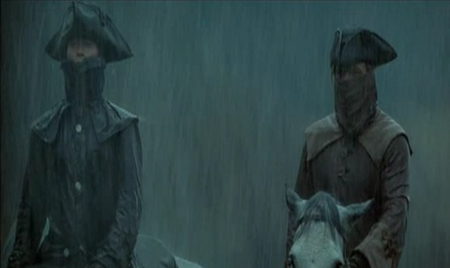 |
 |
| Fronsac and Mani in Brotherhood of the Wolf | |
A hunter (and chief antagonist of the film) by the name of Jean-Francois comes to town to rid everyone of the beast. In a dialogue with Fronsac, he explains his weaponry:
Jean-Francois : It’s a beautiful weapon, isn’t it? I had it made by a gunsmith of Mende when I came back from campaign. You definitely understand that I needed something made for me.
Take it, have a look! Even in Paris you won’t find a bullet like this! I make them myself.
Fronsac : Out of Silver? Are you afraid of werewolves?
 |
 |
| The beast as shown in Brotherhood of the Wolf | |
Fronsac's friend Mani unfortunately meets an untimely end, and as Fronsac is performing an autopsy upon him he discovers a silver bullet. It is this bullet which lets Fronsac know that Jean-Francois had been commanding the beast and its string of deadly attacks all along. Fronsac confronts Jean-Francois about being behind the killings:
Fronsac : Sardis trained you like you trained the beast!
Jean-Francois : And how did you know?
Fronsac : You sign your crimes with a silver bullet.
 |
 |
| Left; "Nothing Zip" hoodie sweatshirt being sold during The High End Of Low era depicting a wolf's head with sharp fangs and a shock symbol arrow. Right; Manson laying on a sofa covered with animal skins, possibly from wolves, in another promo shot for The High End Of Low by Delaney Bishop. |
|
With these details in mind, two verses --one in Leave a Scar, the other in Into the Fire-- reveal more of their intricacies that may have seemed otherwise puzzling.
I'm more like a silver bullet than I'm like a gunMarilyn Manson, Leave a Scar
I'm not easy to hold
I'm moving fast and if I stay in your heart,
I'm certain that this will be the end of your life
This is the filmInto the Fire
Close to the third act and the misery
This isn't rain
You rapist werewolves
This is God pissing down on you
Specifically, the 'rapist werewolves' lyric may likely allude to a scene (non-coincidentally in the later portion or 'third act' of the film) where Francois incestuously rapes and nearly kills his own sister, Marianne.
 |
 |
 |
| Left; "this is the last moon of it's kind for 15 years". Center; "6 am, some goddamn morning... photo by erw". Right; "sometimes a bite just isn't enough." As posted and captioned in Marilyn Manson's Myspace photo albums around January 2010. |
||
Marilyn Manson, about The High End Of LowIt's a phoenix from the fire and a redemption resurrection.
Kerrang, March 2009
Moving on to the primary and elaborate illustration on the cover, we are met with a symbol that is both religious in nature, as well as being linked to another group that Manson has covertly alluded to on a few occasions -- the Freemasons.
 |
 |
| Detail of the Arma-goddamn-motherfuckin-geddon cover (edited for clarity purposes) alongside its source, the “Arms of the Masons”, by Carl Alexander Heideloff, which depicts the square and compass forming a sonnerad (sun wheel) / swastika. Besides evoking the phoenix reference Manson made when talking about the album, the Eagle is actually a reference to St. John, whom this particular group of German Freemasons adopted as their patron saint. As a side note, I use that word “Mason” hesitantly, as the source illustration largely predates the accepted orthodox beliefs of a 16th/17th century Freemason origin, and I would not be surprised to find the brothers of the craft taking offence with what is written. Nonetheless, onwards we plow, to tackle the remaining biblical elements first before moving onto the sonnerad. Note the engraving's date, 1515, is yet another occurence of the number 15 during The High End of Low. | |
The eagle seen is shown with its wings proudly displayed, and the halo around its head identifying it as St. John the Evangelist.
 |
 |
 |
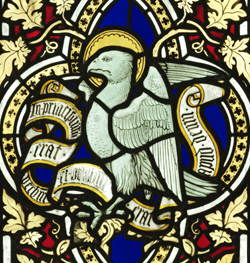 |
Indeed, it was altogether common in Christian art to depict the New Testament Gospel authors in such a manner. Sometimes they were shown to be in close proximity with the animal, at other times only the animal would be portrayed (with a halo behind its head to identify its status) and on a few occasions (though not nearly as often) as an anthropomorphic figure; a coupling of both man and beast. The four authors were often depicted as the following:
- St. Matthew: Depicted as a man, to place emphasis on Jesus' humanity
- St. Mark: Depicted as a lion, to place emphasis on Jesus' royalty
- St. Luke: Depicted as an ox, to place emphasis on Jesus' servility
- St. John: Depicted as an eagle, to place emphasis on Jesus' divinity
 |
 |
It should also be mentioned that this is not the only St. John reference used by Manson; a particular gem was hidden inside the very album itself. On the sacrilegious thirteenth track, 'I Have to Look Up Just to See Hell', Manson repeats,
The light shines in the darkness, and the darkness will never understand itI Have To Look Up Just To See Hell. Track 13, The High End Of Low.
This is a telling nod to The Gospel of St. John, where we may read
And the light shineth in darkness; and the darkness comprehended it notJohn 1:5. King James Bible.
While normally using the King James Version for his biblical references it appears that in this instance Manson may have used the New International Version instead, as the text is closer to the album lyrics – "The light shines in the darkness, but the darkness has not understood it."
This is where perhaps the most interesting subtlety is buried; a reference sub rosa another reference. The chapter and verse of this particular biblical excerpt? John 1:5. With the prominent reemergence of the number 15 in The High End of Low, this cannot be overlooked or written off.
 Israel Regardie's "The Eye In the Triangle" (an interpretation of Aleister Crowley ).
Israel Regardie's "The Eye In the Triangle" (an interpretation of Aleister Crowley ).
The Voice of my Higher Self said unto me: Let me enter the Path of Darkness and, peradventure, there shall I find the Light. I am the only Being in an Abyss of Darkness; from an Abyss of Darkness came I forth ere my birth, from the Silence of a Primal Sleep. And the Voice of Ages answered to my Soul: I am He who formulates in Darkness--the Light that shineth in Darkness, yet the Darkness comprehendeth it not.The Eye In the Triangle, detailing part of the Golden Dawn's Neophyte ritual.
 |
 |
| Left; the Cross crosslet or Mission Cross, made from four Latin Crosses (or two Double Crosses), a symbol for world evangelism of the Christian Gospels commonly interpretated as representing the four evangelists, and which was also used by Aleister Crowley. Right; a similar symbol surrounding the title on the single cover with diamond/lozenge extremities, representing Christ's wounds caused by the Holy Nails, or once again the four evangelists. | |
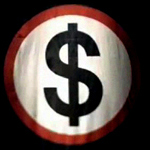
So, no “Swastika.” I said, “Okay… Pretty As A Dollar Sign,” because that’s their fascism now. There’s nothing more fascist now than money. Everyone knows that.Shockhound, interview excerpt
 |
 |
| The podium, banners, microphones, and drums in the video are all emblazoned with the $ symbol, serving as a substitute swastika. The symbol was also prominently used during the subsequent tour, and on MarilynManson.com |
|
 Ginger Fish and Chris Vrenna with ($) drums, on a photograph shot during the video.
Ginger Fish and Chris Vrenna with ($) drums, on a photograph shot during the video.
The choice of this sarcastic logo originates in the track title “Pretty as a Swastika”, a verbatim commentary made by American journalist Walter Winchell regarding film maker Leni Riefenstahl, a woman most notably famous for her film, “Triumph des Willens” (Triumph of the Will), the single greatest Nazi propaganda film ever made. When Riefenstahl made a visit to America, Mr. Winchell said that she was “as pretty as a swastika” (for more, see The High End Of Low lyrical allusions page).
 |
 |
| Leni Riefenstahl, and the poster for her most reconizeable work, The Triumph of the Will. | |
Bearing this fact in mind, most people will notice that the track title is censored, and repackaged under the moniker, “Pretty as a ($)”. This is not merely a substitution of two remotely similar looking symbols, but rather, a veiled reference to Salvador Dalí.
But I was inspired to make the dollar sign because my choices are made artistically; their choices are made financially.Shockhound, interview excerpt
Fellow surrealist and dissatisfied contemporary André Breton is credited with making a pointed attack against Dalí, formulated on Breton’s belief that Dalí had abandoned his artistic integrity and surrealist roots in the pursuit of fame and wealth. Furthermore, (and much like Manson) Dalí was met with accusations of being a Nazi sympathizer who held militaristic and fascist ideologies, due to his unashamed and open fascination with fascism, as mentioned in our "Degenerate" Art section.
 Savador Dalí, bearing a $ moustache; it is said that Breton's accusations merely amused Dalí.
Savador Dalí, bearing a $ moustache; it is said that Breton's accusations merely amused Dalí.
Thus between Dalí’s curious intrigue in fascism, Manson's past evocations of Dalí, and Salvador's poignant $ moustache photograph above, we can reasonably assume that the $ substitution in Pretty as a Swastika was not the result of a trivial parody, (as some have claimed) but rather, a two-fold method of evoking the originally intended presence of the swastika without the explicit need to display it, as well as an indictment of the inherent fascism of money (especially when censorship is applied for nothing more than monetary gain).
 Arma...geddon dollar bill on the "Buck T-shirt" design that surfaced on May, 9th.
Arma...geddon dollar bill on the "Buck T-shirt" design that surfaced on May, 9th. Among other details note the Antichrist Svperstar Shock logo.
 |
 |
| Still frames from the 1978 film, Sgt. Pepper's Lonely Hearts Club Band depicting the band playing amidst $ banners, atop a stage made of stacked coins & bills, and a giant fascistic neon dollar sign. And where Manson's "Buck T-shirt" design above also originates from, as mentioned in our High End Of Low live section. | |
Pertaining to the origins of the dollar-sign,

The word dollar came to America from Germany. The word dollar is derived from the German taler. The name taler was first given to silver coins made in 1519. This metal was mined in Joachimsthal (Joachim's valley, or thaler), in what was then Bohemia. The obverse of one thaler showed the crucified Christ. On the reverse was the image of a serpent, hanging from a cross.Near the serpent's head are the two letters NU and on the other side of the cross, the number 21. This is a reference to the numbers, Chapter 21, of the bible. In this Chapter, we will learn of the people of Israel who began to speak against God because of their tribulations and because they feared that they would die in the wilderness. As punishment, God sent against them fiery serpents. These bit many of the Israelites, as a result of which a number died. The people of Israel recognized their sin and begged for forgiveness. God instructed Moses to make a fiery serpent and set it upon a pole. Thereafter, anyone who looked upon that image would be cursed. Moses did as he was ordered and raised a brazen serpent on a pole; all those who gazed upon it lived. It is this healing metal serpent that is shown on the reverse of the thaler. In this image, the pole has become a cross, as the artist wished to draw a parallel between the magical healing power of this brass serpent and the healing power of Christ, who hung upon the cross. It is this origin that has led some historians to claim that the thaler image of the serpent-cross is the origin of the dollar sign. The Secret Symbols of the Dollar Bill, by David Ovason
 |
 |
| Left; Moses and the Israelites erect the serpent's cross. Right; backstage photograph of Manson behind the ($) podium. | |
6 And the LORD sent fiery serpents among the people, and they bit the people; and much people of Israel died.
7 Therefore the people came to Moses, and said, We have sinned, for we have spoken against the LORD, and against thee; pray unto the LORD, that he take away the serpents from us. And Moses prayed for the people.
8 And the LORD said unto Moses, Make thee a fiery serpent, and set it upon a pole: and it shall come to pass, that every one that is bitten, when he looketh upon it, shall live.
9 And Moses made a serpent of brass, and put it upon a pole, and it came to pass, that if a serpent had bitten any man, when he beheld the serpent of brass, he lived. Numbers 21:6-9 (KJV), Old Testament
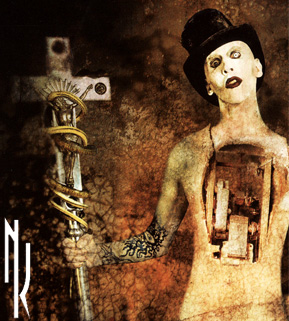
Manson as a Magician holding the bronze serpent coiled around the silver crucifix. "This is also a reference to the story of Moses fastening a bronze serpent to a pole as a cure for snake-bite when the Israelites were crossing the desert towards the Promised Land. According to tradition, the pole was a T-cross, foreshadowing the Crucifixion. 'And as Moses lifted up the serpent in the wilderness, so must the Son of man be lifted up, that whoever believes in him may have eternal life'.NK Tarot & Holy Wood, quote by Richard Cavendish's "The Tarot"
 |
 |
| Two representations of the crucified serpent on a tau cross, set upon the pole by Moses in order to atone for the Israelites forsaking God. According to J.S. Downard in King Kill 33, "in alchemy the Killing of the King was symbolized by a crucified snake on a tau cross, a variant of the crucifixion of Jesus." | |
 |
 |
| Snake standing on its tail and cut through from the right by an arrow, within a thelemic symbol incorporationg the duality of the hexagram, and on the seal of Cagliostro, founder of the Masonic Egyptian Rite. It is said to represent the letters S and I, for Supérieur Inconnu (Unknown Superior in French language), and bears a noticeable similarity to the modern day $ sign. | |
 |
 |
 |
| Above left and below; cover album art of various early albums and EPs by The Swans, circa 1986's Greed/Holy Money release. Noteworthy is that The Swans' former member and producer, Roli Mosimann, was originally taken on to produce Marilyn Manson's 1994 debut, Portrait Of An American, in the hopes that, like his work with The Swans, he would bring out a darker element within the band's sound. Center; Manson's logo as it appears on a banner in the video. Right; a variation of the $ logo at the center of a seven-pointed star which opens the late 2009 MarilynManson.com. |
||
 |
 |
 |
 |

S e e a l s o o n T h e N A C H T K A B A R E T T :
 |
|
THE HIGH END OF LOW - LIVE | 'The High End of Low' live onstage 2009, including further exploration of the ($) theme, such as updated variations of the Nuremburg-esque shock banners adorned with the "almighty dollar", stage light projections of revolving $wa$tikas, other variations of the symbol on backstage passes, and much more on the references behind this logo.

"Capitalism has made it this way, old-fashioned fascism will take it away."Marilyn Manson, The Beautiful People
Antichrist Svperstar
 |
 |
| Print Mafia posters for two 2008 U.S. venues of Marilyn Manson's Rape of The World tour, evoking Manson's capitalism/fascism dichotomy in 'The Beautiful People', and foreseeing the interchangeability of the swastika and dollar sign during the High End Of Low era. | |
As for the shape of the compasses, forming a hidden sonnerad/swastika present on the Arma-goddamn-motherfuckin-geddon cover,
 Similar engraving of a sun wheel made of four compasses illustrating a Masonic ritual.
Similar engraving of a sun wheel made of four compasses illustrating a Masonic ritual.
The first Masonic congress occurred in the city of Straßburg, Germany in the year 1275. It was formed by Grand Master Erwin von Steinbach. This was also the earliest recorded use of the symbol of Freemasons, the square and compasses. Whilst Straßburg was considered the premier grand lodge of the day, other Great Masonic lodges had already been formed in Wien, Bern and the above mentioned Köln (Cologne); these were called Oberhütten or great lodges. Several Masonic congresses were held in the city of Straßburg, including the years 1498 and 1563. At this time the first recorded Arms of the Masons of Germany were recorded depicting four compasses positioned around a pagan sun symbol and arranged in the shape of a swastika or pagan / Aryan sun-wheel. The Masonic Arms of Germany also displayed the name of St John the Evangelist, the patron Saint of German Masons.Excerpt from "The 99° of Freemasonry: Turning the Solomon Key", by Bro. Henning A. Klövekorn
 |
 |
| The sonnerad (sun wheel), and the dollar $wa$tika which surfaced during the High End Of Low tour, on merchandizing items and in hypnotic projections. | |
The sonnerad is a sigil of Germanic origin which has much in common with the Wheel Of Fortune. Like the swastika, and a series of Norse runes, (such as the Wolfsangel, Opfer, Toten, Tyr, Hagal, Sig, and Odal runes, among others) the sigil of the sonnerad was adopted by the Nazi party, most noticeably by the Waffen-SS Nordland and Wiking divisions.
 |
 |
 |
|
Left; the sonnerad within the emblem of the Thule society, a German occultist group which influenced the Nazi ideology. Center; emblazoned upon a tank of the 5th SS Wiking, Panzer Division. |
||
When I see you in the sun you're as pretty as a swastika.Pretty as a Swastika
The term sonnerad (which means “sun wheel”), and its permeation – “The Black Sun” – came to be associated with the more esoteric branches of the Nazi’s, especially under the guidance and direction of vested dabblers in the occult such as Heinrich Himmler and Karl Maria Wiligut. The sonnerad was just one symbol among many to evoke the sun, and more importantly, the purity it contained. This concept of purity was a central driving force behind much of the living mythos that Hitler and the SS tried to indoctrinate in the German people. It was used in many ways as a mystic or ritualistic symbol of Germanic paganism that the Nazi’s were gradually adopting and reimagining in order to supplant the prevalent popularity of Christianity.
 |
 |
| Example of a Schwarze Sonne, (Black Sun) and another photo of the black sun from directly inside Wewelsburg castle –the notorious occult central command of the SS- located in the SS General’s Hall. Within the castle walls rituals were performed, much of them largely based upon Germanic pagan origins and concepts of Valhalla, the quest for the Holy Grail, and other tales surrounding issues of nobility, purity, or divinity. | |
 |
 |
| Manson donning the SS infantry hat in the video for Arma-goddamn-mother-fuckin-geddon. | |
A far more direct allusion to fascism can be spotted in the video for Arma-goddamn-motherfuckin-geddon, wherein Manson specifically wears an infantry helmet of the SS. This is the same helmet that can be seen in one of the first promotional images to surface for The High End of Low, taken within the walls of Manson’s own bedroom.
 |
 |
| Two early promo pictures of Manson -wearing the same helmet- in the sanctuary of his bedroom, the walls of which are covered with the album's lyrics and various items witnessing the story of the record, including a giant chrome spray paint swastika as revealed in the Shockhound interview. The left one was actually unveiled in the album's artwork, and also features Manson's swastik-esque tattoo of the Heart of Tursas, an ancient Finnish symbol. | |
 |
 |
| Example of the SS Helmet, and a propaganda poster of the Waffen-SS. | |
 Still frame from the Arma...Geddon video : note the double cross hiding in the shadows at Manson's right.
Still frame from the Arma...Geddon video : note the double cross hiding in the shadows at Manson's right.
Subtle clues scattered in the video and era imagery bring back to the Celebritarian philosophy, notably the Double Cross that represents it. Besides signifying Manson's concept is still alive and well, though rather latent, the references act above all as an illustration of the High/Low dichotomy omnipresent in Manson's work, and finding its paroxism in the album's title The High End Of Low. The Hermetic maxim "As above, so below" materialized with the symbol's shape is also in perfect continuity with the Heaven/Hell dichotomy present in "Tengoku to Jigoku", which was a big influence on the album's title and imagery.
 |
 |
 |
| Center; Marilyn Manson "Spread Eagle" tour shirt, reproducing the Nazi "Reichsadler" (left), with the swastika not substituted with the dollar sign this time, but the Celebritarian Double Cross. The cross also appears on the back (along with the M/M15 logo), where it's formed by the tour dates (just like they were assembled in an inverted cross on a shirt from the Guns, God & Government tour). The pattern formed by the grey crosses in the background are evocative of planes from Nazi propaganda imagery (right), while the red color evokes Manson's identification to the Phoenix evoked earlier, and the idea of getting his wings back. Note that the Golden Age Of Grotesque MM diamond logo was also inspired from another depiction of the Nazi eagle. | ||
Furthermore, Manson has been photographed on a number of occasions during this time, once again displaying his Celebritarian ring, which is infamously emblazoned with the double cross. The symbol also appears during the live performances of the era, with the keyboard stand resurrected from the Rape Of The World tour.
 |
 |
| Manson's Pentagram and Celebritarian Double Cross rings. Photographed by Chris McAndrew. | |
 |
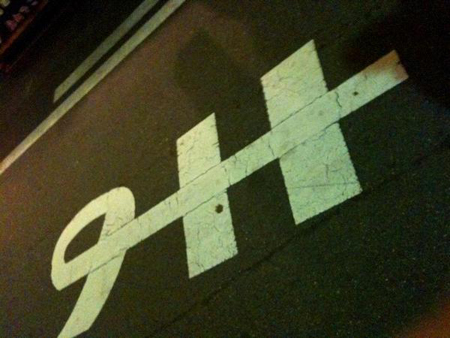 |
| The double cross on the wall of Manson's bedroom, as seen in the album art for The High End of Low. | "i like what it is but i don't know what it means." Picture from Japan published on Manson's Myspace. |
 |
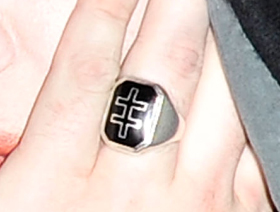 |
| Manson photographed with the Celebritarian ring at an album signing for The High End of Low. | |
 From MarilynManson.com splash page.
From MarilynManson.com splash page.
I had said to my ex-girlfriend : "You're as pretty as a swastika", because she was very white with black hair and had red lipstick. Her skin color was also reminiscent of the Mickey Mouse Club members.Marilyn Manson, interview for RockOne, June 2009
Translated from French
 The blackface utilized heavily during the era of The Golden Age of Grotesque, with the
The blackface utilized heavily during the era of The Golden Age of Grotesque, with the visual collaboration between Marilyn Manson and Gottfried Helnwein.
The devils are girls with Van Gogh's missing earThe Golden Age Of Grotesque
 |
 |
| Left; Manson in blackface and mousears on the Helnwein photograph originally intended to be used as a cover for The Golden Age of Grotesque. Note the ear is cut to avoid copyright infringement. Right; 'Anaclitism', Pernod and watercolor, a double-connection to Vangogh's cut ear and Mickey Mouse's features. For more on Blackface and references to the mouse, visit the Rodent Death Head logo, as well as the "Degenerate" Art articles of The Nachtkabarett. | |
 |
 |
| “Give me a picket sign, make it blank and white.” The girls in the video can be seen bearing (and then assaulting Manson with) blank and white picket signs, an allusion to the title of this other apocalyptic track (for more on this visit the High End Of Low lyrical evocations page). | |
 Backstage picture published on Manson's Facebook and took during the Arma...Geddon video shooting.
Backstage picture published on Manson's Facebook and took during the Arma...Geddon video shooting.
I'm sick of immortalityI Want To Kill You Like They Do In The Movies
 |
 |
| Manson bearing gloves with skull & bones insignia. The symbol has largely come to be associated with the concept of Memento Mori, which is the recognition of one’s own mortality and the acknowledgement that all paths ultimately lead to the same destination (the grave). | |
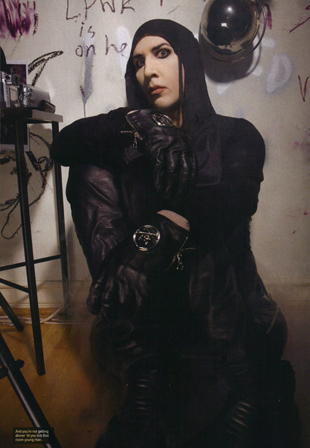 |
 |
| Manson wearing the same skull & bones gloves in Kerrang's May 2009 issue. | |
 Manson posing next to a skull in the album's artwork, alluding to the concept of memento mori - the inevitability of death, set juxtaposed within a theatric, cinematic context -- i.e., I Want to Kill You Like They Do in the Movies. See The High End Of Low - Era.
Manson posing next to a skull in the album's artwork, alluding to the concept of memento mori - the inevitability of death, set juxtaposed within a theatric, cinematic context -- i.e., I Want to Kill You Like They Do in the Movies. See The High End Of Low - Era.

